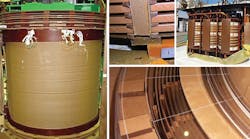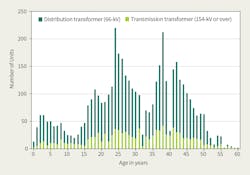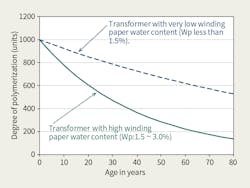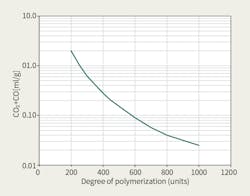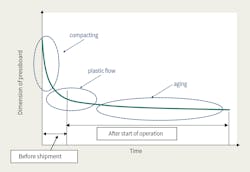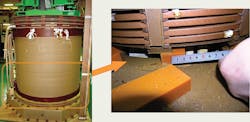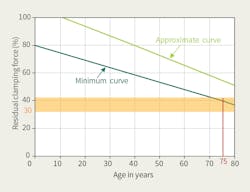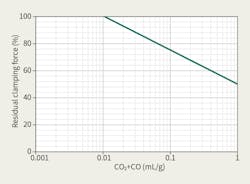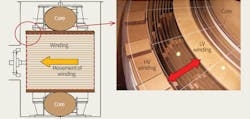Transformers are designed with an expected life span of 30 years, though some in Japan have been in service for more than for 50 years. The need to replace transformers can be determined by evaluating individual conditions, but to plan a long-term transformer replacement program, it is necessary to determine the life expectancy of the asset.
To investigate the effect of transformer aging, TEPCO Power Grid Inc. decommissioned 20 transformers with a service life of between 30 years and 50 years to evaluate the level of deterioration from aging. This study included the following transmission and distribution transformers:
• Nine transmission transformer units in the voltage range of 275 kV to 500 kV with ratings ranging from 200 MVA to 1000 MVA. These transformers ranged in age from 27 years to 52 years.
• Eleven distribution transformer units with a primary voltage of 66 kV had ratings ranging from 10 MVA to 20 MVA. These transformers ranged in age from 13 years to 50 years.
Water Content Effect
For substation transformers that had a low load factor while in service, TEPCO’s investigation found the decisive factor in determining transformer life span was the result of a decrease in clamping force applied to the windings, because of the shrinkage in insulation and influence on the mechanical capability. This finding was not the result of a decrease in degree of polymerization (DP), as currently considered by utilities.
However, an increased level of DP can be caused by incomplete drying during the manufacturing process and high residual water retention in the insulation paper. This accelerated rate of decrease in the DP has a direct influence on a transformer’s service life.
TEPCO investigated the DP of the winding paper and pressboard insulation of the 20 decommissioned transformers to determine the water content and dissolved gas in oil. Designed with conservators as a preventive measure for oil degradation, these transformers were subject to a 40% to 60% load factor when in commission. The degradation rate of a transformer with high-water content in the winding paper (1.5% to 3%) is faster than that of a transformer with low-water content in the paper (less than 1.5%).
Considering a DP of 400 corresponds to the design life of a transformer, units with high-water content in the paper have an approximate life span of 40 years while units with low-water content in the paper have an approximate life span of 80 years. In general, transformers manufactured before the 1980s have above-average water content in the paper insulation, as the drying conditions and allowable water content were not specified at the time. Hence, in case of a transformer with low-water content in the paper, the decreasing DP is not a decisive factor in determining the transformer’s life span.
Several other measurements can be obtained from the transformer insulating oil, including the CO2 + CO and acetone content that can be used to estimate the DP. For conservator-type transformers that are standard at TEPCO, the DP can be determined precisely from CO2 + CO because a high correlation was observed in the relationship between the DP and CO2 + CO.
Winding Clamping Force
The end insulation of the transformer winding comprises pressboard and spacers arranged at the top and bottom of the winding, which are clamped by metal fittings. When insulation shrinkage occurs, the clamping force decreases. Shrinkage of the insulation can be separated into three stages:
1. The first is compaction of the cellulose fiber on entry to the gap, caused by the drying and pressurizing process.
2. This is followed by the second stage of plastic flow when fibers are crushed by the pressure of the heat cycle.
3. The third stage is aging that causes fiber breaks by thermal degradation. These characteristics can be different depending on the transformer manufacturer.
Short Circuits
When the clamping force exerted on the winding decreases, the strength of the buckling decreases relatively as a result of a decrease in the axial clamping force during a short circuit. Buckling occurred when the initial clamping force was 100% and the residual clamping force was decreased below approximately 30%. The clamping force decreases with the elapsed times, and the transformer life is assumed to be about 70 years to 80 years, though it depends on the load factor when the clamping force—which begins to influence the machine force—decreases 30% to 40% during short-circuit conditions.
TEPCO’s investigation confirmed the decrease in clamping forces and the volume of CO2 + CO generation are correlated. Therefore, if the initial clamping force can be obtained from the manufacturing acceptance test results, it is possible to assume the residual clamping force quantitatively from CO2 + CO, because the generation of CO2 + CO is related to the aging process by thermal degradation.
The utility’s investigation found the first clamping force for winding was different (1-3 N/mm2) depending on the manufacturer. It also was different depending on the drying process, drying duration and presence of additional clamping. Thus, the correlation between residual clamping force and CO2 + CO that occurs during operation is different. Therefore, it is important to confirm the design value with the manufacturer and check the decreased clamping force at the factory.
Seismic Resistance
TEPCO’s transformer specification includes the need for seismic resistance to withstand the earthquakes that occur in Japan. For example, there was considerable displacement of a transformer winding because of an earthquake in a 23-year-old 500-kV transformer operating with a high load factor. The winding moved 15 mm (0.59 inches), increasing the gap between the high-voltage and low-voltage windings. In addition, the duct spacers collapsed between the pressboard. The seismic acceleration was 890 gal at ground level and 1720 gal at the transformer’s center of gravity. This exceeded the Japan Electric Association’s design specification of 500 gal, which is equivalent to 0.5 m/sec2 (1.64 ft/sec2).
The displacement of the transformer winding coil also was noted in the other transformers, from different manufacturers, located at the same power plant. As a result of the investigation undertaken when the transformer was decommissioned, the clamping force had decreased by approximately 60% and the winding displacement decreased by 40%.
When the clamping force decreases as a result of thermal degradation, displacement of the winding occur even in the event of a minor earthquake. The evaluation of winding displacement as a result of earthquakes is necessary in Japan, which experiences frequent earthquakes. It also is used as a means for judging the necessity to repair 60 – 500 kV /275 kV transformers whose seismic movements at ground level were extremely large as a result of the Great East Japan earthquake that occurred in 2011.
Life Expectancy
TEPCO has established a life expectancy of 65 years for extra-high-voltage/HV transformers and 75 years for distribution transformers, as these are the time periods when winding clamping force begins to decrease, causing a marked influence on mechanical performance. However, as the life expectancy of a transformer subject to rapidly decreasing DP as a result of high-water content in the paper insulation or where the risk of failure has been established, premature replacement of the transformer is necessary.
